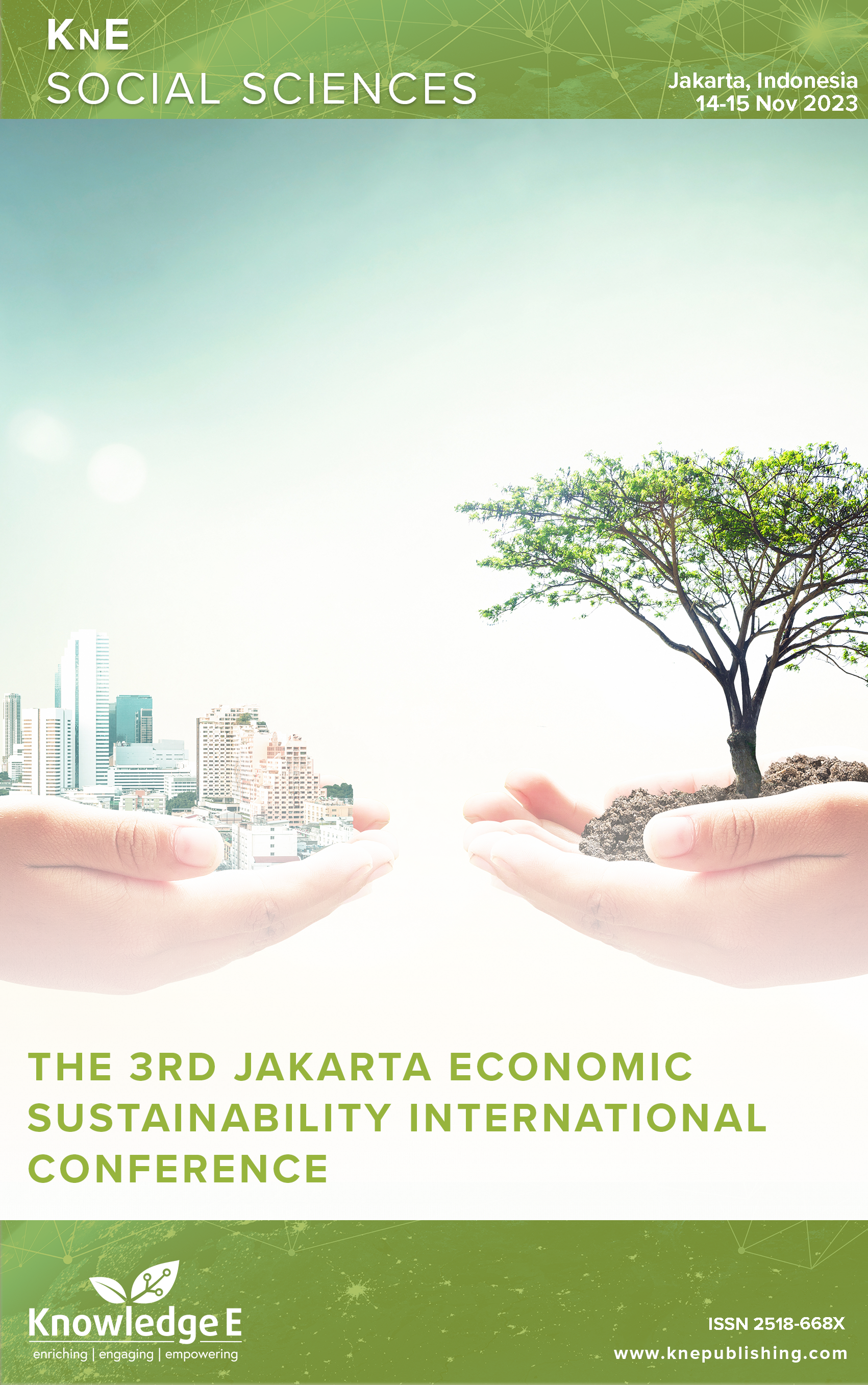The Role of Credit Facilities and Micro and Small Enterprises (MSEs) in Enhancing Rural Development Performance (A Study in Villages in Central Sulawesi Province)
DOI:
https://doi.org/10.18502/kss.v9i20.16547Abstract
This research aims to analyze the extent to which the presence and role of credit facilities and micro and small enterprises (MSEs) in rural areas contribute to village development, especially in achieving the Village Development Index (VDI), which comprises three dimensions: the Social Resilience Index (SRI), Economic Resilience Index (ERI), and Environmental Resilience Index (EnRI). This study uses a quantitative method and cross-sectional data from 1842 villages in the Central Sulawesi Province sourced from the 2021 village potential data provided by the Central Statistics Agency, with a final sample of 1783 observations. The results indicate that the presence of both credit facilities and MSEs in rural areas has contributed to the achievement of VDI. Additionally, it was found that the presence of MSEs can mediate the influence of credit facilities on VDI. The existence of credit facilities in rural areas encourages the increase of MSEs in those areas, which in turn contributes to the improvement of VDI. The findings imply that for the strategy of accelerating rural development in Indonesia, the government, regional governments, financial institutions (banks and non-banks) and other stakeholders need to establish policies to enhance collaboration and innovative programs for the empowerment of village communities, including the provision of accessible, affordable, and reachable credit facilities for rural communities. The existence of such programs is expected to stimulate an increase in the number of MSEs and enhance economic activities in rural areas. This will then lead to an improvement in VDI.
Keywords: credit facilities, micro and small enterprises, rural development, village development index
References
Puspayanthi NLPAD, Wahyuni MA, Prayudi MA. 2017. Penguatan pengelolaan keuangan desa dan optimalisasi peran BUMDes untuk kemandirian desa pada desa di Kabupaten Jembrana. JIMAT ( Jurnal Ilmiah Mahasiswa Akuntansi) Undiksha, 8(2).
Beck T, Demirgüç-Kunt A, Maksimovic V. Financial and legal constraints to growth: does firm size matter? J Finance. 2005;60(1):137–77. DOI: https://doi.org/10.1111/j.1540-6261.2005.00727.x
Adamowicz M, Zwolińska-Ligaj M. 2020. (2020). The “Smart Village” as a way to achieve sustainable development in rural areas of Poland. DOI: https://doi.org/10.3390/su12166503
Toran VL. Nema DK. 2019. Role of micro, small and medium enterprises (msmes) in achieving sustainable development goals. International Journal for Research in Engineering Application & Management (IJREAM), 04(12), 2454–9150. https://ssrn.com/abstract=3669470
Anggraini NW, Sutopo DS. Village government efforts in realizing the highest national building village Index (IDM) in Ngroto Village. Ecoplan. 2021;4(2):142–50. DOI: https://doi.org/10.20527/ecoplan.v4i2.388
Nyakado A, Okello S. 2016. Effect of accessing bank credit facilities. International Journal of Information Research and Review, 3 (7), 2623, 2626.
Hall G, Hutchinson P, Michaelas N. Industry effects on the determinants of unquoted SMEs’ Capital structure. Int J Econ Bus. 2000;7(3):297–312. DOI: https://doi.org/10.1080/13571510050197203
Freel MS. Perceived environmental uncertainty and innovation in small firms. Small Bus Econ. 2005;25(1):49–64. DOI: https://doi.org/10.1007/s11187-005-4257-9
Beck T, Demirguc-Kunt A. Small and medium-size enterprises: access to finance as a growth constraint. J Bank Finance. 2006;30(11):2931–43. DOI: https://doi.org/10.1016/j.jbankfin.2006.05.009
Fatoki OO, Asah F. The impact of firm and entrepreneurial characteristics on access to debt finance by SMEs in King Williams’ Town, South Africa. Int J Bus Manage. 2011;6(8):170–9. DOI: https://doi.org/10.5539/ijbm.v6n8p170
Barrett CB, Reardon T, Webb P. Nonfarm income diversification and household livelihood strategies in rural Africa: Concepts, dynamics, and policy implications. Food Policy. 2001;26(4):315–31. DOI: https://doi.org/10.1016/S0306-9192(01)00014-8
Yunus M. 2007. Summary: Banker to the Poor by Muhammad Yunus. October, 296. http://www.capitolreader.com/bonus/BankertothePoor.pdf
Dercon S, Christiaensen L. Consumption risk, technology adoption and poverty traps: Evidence from Ethiopia. J Dev Econ. 2011;96(2):159–73. DOI: https://doi.org/10.1016/j.jdeveco.2010.08.003
Banerjee AV, Duflo E. Do firms want to borrow more? Testing credit constraints using a directed lending program. Rev Econ Stud. 2014;81(2):572–607. DOI: https://doi.org/10.1093/restud/rdt046
Bajaj P, Selvakumar K. 2017. The emergence of micro, small and medium-sized enterprises: Enhancing their role in international trade. Emerging Trade Issues for Small Developing Countries, 151.
Dowling J, Pfeffer J. Organizational legitimacy: Social values and organizational behaviour. Pac Sociol Rev. 1975;18(1):122–36. DOI: https://doi.org/10.2307/1388226
Sari NT, Kusumawati A. Literature review: The efforts to strengthen of micro, small and medium-sized enterprises (MSME) in Indonesia. Asian Journal of Management. Entrepreneurship and Social Science. 2022;2(01):98–115.
Gichuki JA, Njeru A, Tirimba OI. Challenges facing micro and small enterprises in accessing credit facilities in Kangemi Harambee market in Nairobi City County, Kenya. International Journal of Scientific and Research Publications. 2014;4(12):1–25.
Haile MM. Factors affecting micro and small enterprises in accessing credit facilities: A Study in Gesuba Town. Ethiopia: Wolaita Zone, Southern Nation Nationalities Peoples Regional State; 2020.
Wijaya PY, Hutnaleontina PN, Ismayanthi TIT. 2019. Social capital effectiveness toward competitive advantage and business performance (Case study of Village Credit Institutions In Gianyar Regency, Bali, Indonesia). Scientific Papers: Management, Economic Engineering in Agriculture & Rural Development, 19(3).
Furqan AC, Karim F. Problematika Praktik Akuntansi pada Usaha Mikro, Kecil dan Menengah (UMKM), serta Keterkaitannya terhadap Akses Kredit. Media Litbang Sulawesi Tengah. 2012;5(1):23–35.
Furqan AC, Karim F, Yuniar LS, Gunarsa A. The effects of information and communication technology on village development performance. International Journal of Data and Network Science. 2023;7(4):1941–8. DOI: https://doi.org/10.5267/j.ijdns.2023.6.018

